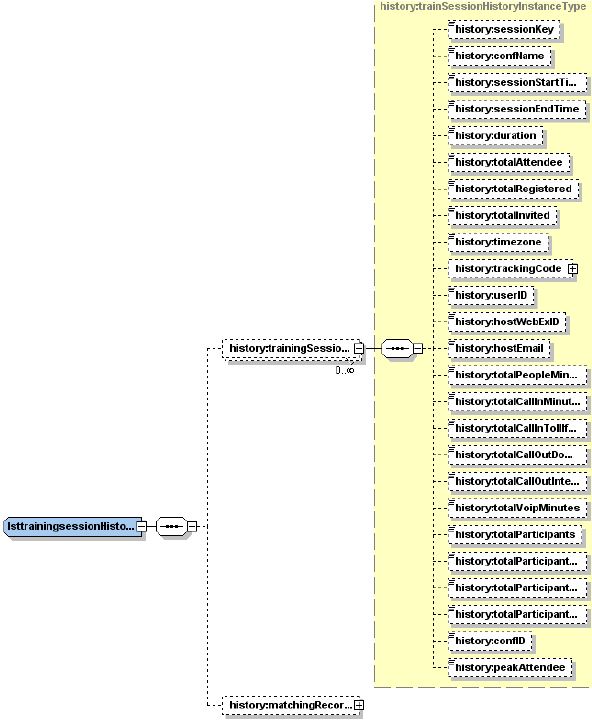LsttrainingsessionHistory
Allows training session hosts or site administrators to request detailed
usage data for previously hosted training sessions, such as the number
of attendees, and the session duration. This command enables external
users and third-party systems to prepare flexible usage reports in
formats other than WebEx online reports.
Note A host can only access his or her own training session history,
but a site administrator can access the history of all the training
sessions hosted on his or her site. When a site administrator specifies
a hostWebExID, the system returns the data of the specified host's
sessions; if a hostWebExID is not specified, all training sessions on
his or her site will be returned. If you are not a site administrator,
the element hostWebExID will be ignored.
Request
The sample XML document shows an example of a request for a list of training sessions previously hosted on the site.
<?xml version="1.0" encoding="UTF-8"?>
<serv:message xmlns:xsi="http://www.w3.org/2001/XMLSchema-instance">
<header>
<securityContext>
<webExID>hostid</webExID>
<password>hostpassword</password>
<siteID>0000</siteID>
<partnerID>9999</partnerID>
<email>johnsmith@xyz.com</email>
</securityContext>
</header>
<body>
<bodyContent xsi:type=
"java:com.webex.service.binding.history.LsttrainingsessionHistory">
<startTimeScope>
<sessionStartTimeStart>03/28/2004 02:31:24
</sessionStartTimeStart>
<sessionStartTimeEnd>04/2/2004 02:31:24</sessionStartTimeEnd>
</startTimeScope>
<endTimeScope>
<sessionEndTimeStart>03/28/2004 03:31:24</sessionEndTimeStart>
<sessionEndTimeEnd>04/2/2004 03:31:24</sessionEndTimeEnd>
</endTimeScope>
<listControl>
<serv:startFrom>1</serv:startFrom>
<serv:maximumNum>12</serv:maximumNum>
<serv:listMethod>AND</serv:listMethod>
</listControl>
<order>
<orderBy>CONFNAME</orderBy>
<orderAD>ASC</orderAD>
</order>
</bodyContent>
</body>
</serv:message>
The following schema diagram shows the structure of the elements in the lsttrainingsessionHistory request message.
Figure 9-23 • Schema diagram for lsttrainingsessionHistory
For descriptions of the global elements in the security context of the header, please see Global Request Elements in Security Context. For descriptions of the non-global elements, please refer to “Elements in WebEx XML Schema Definitions for the History Service”.
Response
The sample XML document shows an example of a possible response to the preceding request document.
<?xml version="1.0" encoding="UTF-8"?>
<serv:message xmlns:serv="http://www.webex.com/schemas/2002/06/service"
xmlns:com="http://www.webex.com/schemas/2002/06/common"
xmlns:history="http://www.webex.com/schemas/2002/06/service/history">
<serv:header>
<serv:response>
<serv:result>SUCCESS</serv:result>
<serv:gsbStatus>PRIMARY</serv:gsbStatus>
</serv:response>
</serv:header>
<serv:body>
<serv:bodyContent xsi:type="history:LsttrainingsessionHistoryResponse"
xmlns:xsi="http://www.w3.org/2001/XMLSchema-instance">
<history:trainingSessionHistory>
<history:sessionKey>87745560</history:sessionKey>
<history:confName>java for XML schedule meeting
</history:confName>
<history:sessionStartTime>03/29/2004 01:31:24
</history:sessionStartTime>
<history:sessionEndTime>03/29/2004 01:41:25
</history:sessionEndTime>
<history:duration>11</history:duration>
<history:totalAttendee>1</history:totalAttendee>
<history:totalRegistered>4</history:totalRegistered>
<history:totalInvited>4</history:totalInvited>
<history:timezone>4</history:timezone>
<history:userID>479422751</history:userID>
<history:hostWebExID>xml</history:hostWebExID>
<history:hostEmail>xml@sz.webex.com</history:hostEmail>
<history:totalPeopleMinutes>11</history:totalPeopleMinutes>
<history:totalCallInMinutes>0</history:totalCallInMinutes>
<history:totalCallInTolllfreeMinutes>0
</history:totalCallInTolllfreeMinutes>
<history:totalCallOutDomestic>0</history:totalCallOutDomestic>
<history:totalCallOutInternational>0
</history:totalCallOutInternational>
<history:totalVoipMinutes>1</history:totalVoipMinutes>
<history:totalParticipants>1</history:totalParticipants>
<history:totalParticipantsVoip>0</history:totalParticipantsVoip>
<history:totalParticipantsCallIn>0
</history:totalParticipantsCallIn>
<history:totalParticipantsCallOut>0
</history:totalParticipantsCallOut>
<history:confID>4702308</history:confID>
<history:peakAttendee>1</history:peakAttendee>
</history:trainingSessionHistory>
<history:matchingRecords>
<serv:total>1</serv:total>
<serv:returned>1</serv:returned>
<serv:startFrom>1</serv:startFrom>
</history:matchingRecords>
</serv:bodyContent>
</serv:body>
</serv:message>
The following schema diagram shows the structure of the elements in thelsttrainingsessionHistoryResponse message.
Figure 9-24 • Schema diagram for lsttrainingsessionHistoryResponse
The result and exceptionID global elements allow you to confirm that an instantiation request was successful. They are described in "Global Response Elements Showing Results and Errors”.

